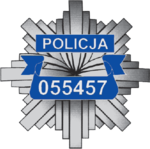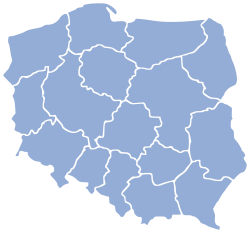Polish Police
Policja  |
|
|---|---|

Badge of Policja
|
|
| Agency overview | |
| Formed | 1919 |
| Preceding agency | Milicja Obywatelska (Citizens' Militia) |
| Employees | 100.000 (officers) 25.000 (civilians) |
| Annual budget | 9.3 billion PLN (2009) |
| Legal personality | Governmental: Government agency |
| Jurisdictional structure | |
| National agency | PL |
 |
|
| Jurisdiction of the Policja | |
| Constituting instruments | |
| General nature | |
| Operational structure | |
| Headquarters | Warsaw |
| Minister responsible | Mariusz Błaszczak, Ministry of Internal Affairs (Ministerstwo Spraw Wewnętrznych) |
| Agency executive | Chief inspector Jarosław Szymczyk, Komendant Główny Policji (Commander in Chief of Policja) |
| Policja Regional HQs | 17 + 5 training centers |
| Website | |
| Policja (English) | |
Policja (Polish pronunciation: [pɔˈlit͡sja]) is the generic name for the police in Poland. The Polish police force was known as policja throughout the Second Polish Republic (1918–1939), and in modern post-communist Republic of Poland since 1990. Its current size is 100,000 officers and ca. 25,000 civilian employees. Among the branches in the force are: Criminal Service, Traffic Police Service, Prevention Service and Supporting Service. Most towns and some villages have their own city guards, which supervise public order and road safety. However, city guards have jurisdiction only over misdemeanors and in cases of crimes may serve only in a supportive role for the state police.
The force's name, Policja, translates into the English language as Police.
An individual officer is typically called a policjant (plural policjanci); these are not, however, official titles and are not included in the official rank structure, they are simply terms used to refer to any police officer regardless of the rank they may hold. A police station is known as Komenda Policji or Komisariat Policji both of which translate more or less into English as Police Commissariat. Female officers may be referred to as policjantki, the singular of which is policjantka.
On the whole, officers' individual ranks are not used by the general public and thus when addressing an officer, it is common to hear the term Pan (female - Pani), Polish for mister/miss used to refer to police officers. On occasion, this may or may not be followed by the term Oficer.
In 1919, with the re-independence of the Polish nation, the state reorganised itself along non-federalist lines and established a centralised form of government. Under the auspices of the new government, a new national police force was formed; this 'Polish State Police' (Policja Państwowa) then existed as the primary law enforcement agency for the entire nation up until the outbreak of the Second World War in 1939. During the inter-war period, a number of key law enforcement duties were delegated to other formations, such as the Border Guard and Military Gendarmerie.
...
Wikipedia
